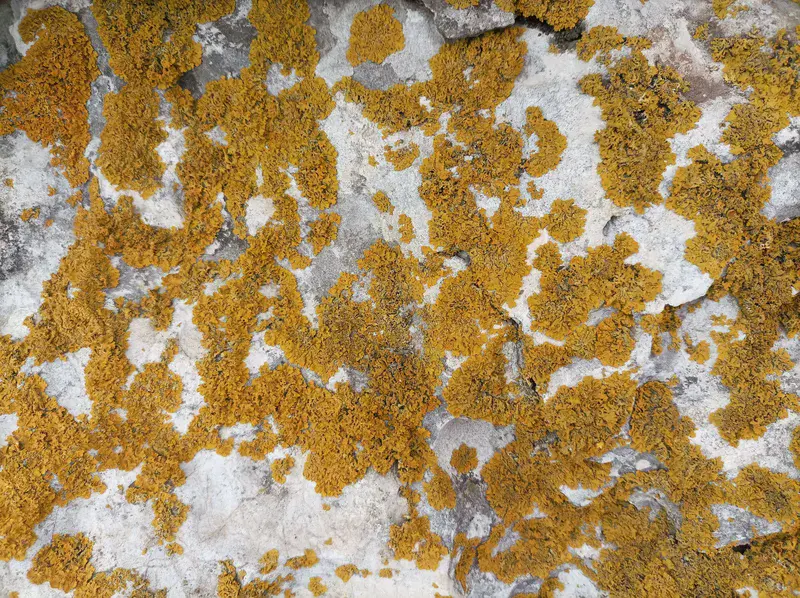
Lichen on limestone at the Gibraltar Rock Nature Reserve
by Antonio Jordán, University of Seville, Sevilla, Spain
First, in English:
The photograph shows a lichen crust on limestone rock at the top of the Rock of Gibraltar. Lichens are the result of the symbiotic relationship between an algae and a fungus. They are present in almost all known ecosystems. They are capable of adapting to a very wide range of environments as well as extreme weather conditions.
Separately, the two types of organism that unite in lichen (algae and fungus) could not colonize these systems, but the relationship between them does allow it.
The alga can obtain carbon through photosynthesis and, when cyanobacteria are present in the relationship, atmospheric nitrogen through fixation processes. Once its requirements for these two nutrients are satisfied, the alga gives the surplus to the fungus in the form of sugar alcohols, glucose or fixed nitrogen.
On the other hand, the fungus "attacks" the rock by releasing organic acids, which contribute to the solubilization of mineral nutrients that can pass to the algae. The fungus anchors the algae to the substrate, provides protection against desiccation and a greater capacity for water absorption.
For these exchanges to take place, the fungus must be able to somehow "penetrate" the cells of the algae, which it achieves by means of haustoria. The haustoria are a type of hypha (fibers that form the tissue of the fungus) that adheres to the wall of plant cells and surrounds them, thus increasing the surface area in contact between them.
In this way, the lichen can colonize environments that are too dry and poor in nutrients for the algae and too poor in carbon for the fungus. For this reason, lichens play an important role in primary colonization, rock weathering (in the early phases of soil formation) and the cycling of elements in nature.
You can red some more about lichens and extreme colonizers at my blog (in Spanish: https://gsoil.blogspot.com/2023/07/colonizadores-extremos.html)
Ahora, en español:
La fotografía muestra una costra de líquenes sobre roca caliza en la cima del Peñón de Gibraltar. Los líquenes son el resultado de la relación simbiótica entre un alga y un hongo. Están presentes en casi todos los ecosistemas conocidos. Son capaces de adaptarse a un rango muy amplio de ambientes así como a condiciones climáticas extremas.
Por separado, los dos tipos de organismo que se unen en el liquen (alga y hongo) no podrían colonizar estos sistemas, pero la relación entre ellos sí lo permite.
El alga puede obtener carbono mediante fotosíntesis y, cuando las cianobacterias están presentes en la relación, nitrógeno atmosférico mediante procesos de fijación. Una vez que sus requerimientos de estos dos nutrientes están satisfechos, el alga cede el excedente al hongo en forma de glicitoles, glucosa o nitrógeno fijado.
Por otro lado, el hongo "ataca" a la roca mediante la liberación de ácidos orgánicos, lo que contribuye a la solubilización de nutrientes minerales que pueden pasar al alga. El hongo ancla el alga al sustrato, proporciona protección frente a la desecación y mayor capacidad de absorción de agua.
Para que se produzcan estos intercambios, el hongo debe ser capaz de "penetrar" de alguna manera en las células del alga, lo que consigue mediante haustorios. Los haustorios son un tipo de hifa (las fibras que forman el tejido de los hongos) que se adhiere a la pared de las células vegetales y las envuelve, aumentando así el área de superficie en contacto entre ambos.
De esta forma, el liquen puede colonizar ambientes demasiado secos y pobres en nutrientes para el alga y demasiado pobres en carbono para el hongo. Por esta razón, los líquenes juegan un papel importante en la colonización primaria, la alteración de la roca (en las primeras fases de la formación del suelo) y el ciclo de los elementos en la naturaleza.
Puedes leer más sobre líquenes y colonizadores extremos en mi blog (https://gsoil.blogspot.com/2023/07/colonizadores-extremos.html)
Categories
Location
- Europe (3893)
- Southern Europe (1691)
- Gibraltar (5)
- Exact location (-5.3452 W, 36.1308 N)
Tags
Colours
Image properties
4000 × 2992 px;
image/jpeg; 3.1 MB
Camera:
Xiaomi M2103K19G
Taken on 30
July
2022
Submitted on 1 August 2022
Licence
Creative Commons Attribution-ShareAlike 3.0 Unported (CC BY-SA 3.0)
Credit
Antonio Jordán (distributed via imaggeo.egu.eu)
Share
Appreciate
Report